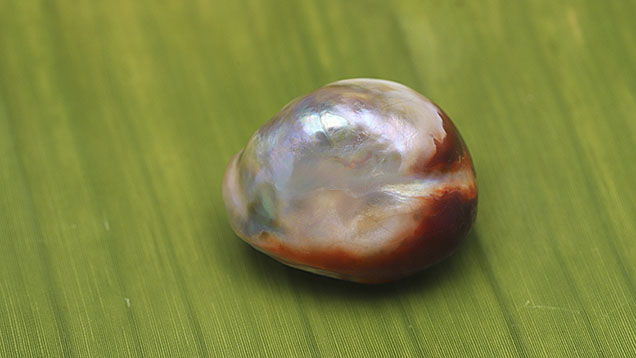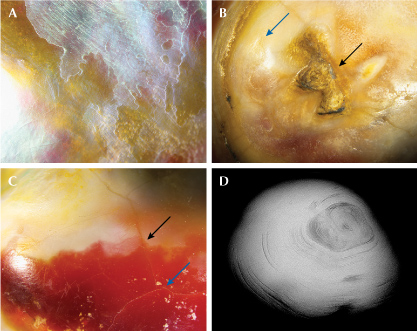A Large Multicolored Natural Blister Pearl

Pearls have always been renowned for their beauty and mystical allure. From the wide range of pearls examined in GIA’s Mumbai laboratory, one recent submission was highlighted for its remarkable size and unique multicolored appearance. The baroque-shaped natural blister pearl weighed 90.08 ct and measured 28.66 × 22.19 × 18.50 mm (figure 1).

The surface exhibited an array of colors. The top was an attractive silvery white with strong orient, while the sides displayed various shades of red ranging from orangy red to dark red with a yellowish cream hue on the base. Under high magnification, a nacreous area with a fine platy structure was observed on the top, and a non-nacreous area on the side and base displayed a complex crystalline structure along with minor surface-reaching cracks (figure 2, A–C). When exposed to long-wave ultraviolet radiation, the red part of the pearl was inert, while the silvery white area emitted a moderate greenish yellow reaction, which is a common reaction for unprocessed and untreated pearls.
Energy-dispersive X-ray fluorescence spectrometry on multiple spots of the surface revealed a magnesium range from below detection limits up to 35 ppm and strontium levels ranging from 1031 to 2646 ppm, indicating a saltwater origin. Real-time X-ray microradiography (RTX) imaging showed an off-center organic-rich core surrounded by concentric growth arcs following the pearl’s shape (figure 2D). This distinctive internal structure corresponded to those observed in natural whole pearls. However, the presence of a worked area on the base indicated the pearl had once been attached to a mollusk’s shell. Therefore, it was identified as a natural blister pearl (“Natural shell blisters and blister pearls: What’s the difference?” GIA Research News, August 26, 2019).

Raman analysis was conducted on two spots using an 830 nm laser excitation due to higher background fluorescence in this sample. The nacreous area showed peaks at 701, 704, and 1085 cm–1 indicative of aragonite, while the non-nacreous orangy red area revealed peaks at 283, 712, and 1085 cm–1 indicative of calcite (figure 3). Ultraviolet/visible reflectance spectra on the same spots showed reflectance minima at around 280 nm and an area of lower reflectance between 420 and 500 nm, similar to that observed in pearls from the Pinctada maxima mollusk.
Since no indication of color pigments was observed on the nacreous portion of the pearl, the various colors seen on the nacreous surface were likely due to the iridescent effect in the multilayered aragonite platelet structure, similar to abalone pearls. The cause of the red coloration on the non-nacreous area remains unclear; however, no indications of treatment were identified. According to previous studies on pen pearls (e.g., Fall 2009 Gem News International, pp. 221–223), red coloring in pen pearls is associated with carotenoid pigments, and porphyrins may be responsible for imparting a red color. However, the Raman peaks reported in those studies were not detected in this sample.
This large multicolored natural blister pearl with both nacreous and non-nacreous surfaces is an intriguing product of nature.



